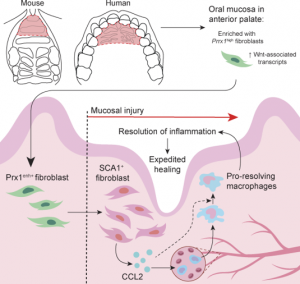Penn Dental Medicine Study Illuminates Wound Healing
 Philadelphia – While oral wounds are known to heal rapidly with limited scarring, the mechanism has remained elusive. However, a recent study led by Penn Dental Medicine’s Dr. Kang Ko, Assistant Professor in the Department of Periodontics, illuminates that process, identifying a distinct oral fibroblast progenitor that promotes mucosal healing. The findings were recently published in the Journal of Experimental Medicine (JEM) and also highlighted in a JEM Insight article.
Philadelphia – While oral wounds are known to heal rapidly with limited scarring, the mechanism has remained elusive. However, a recent study led by Penn Dental Medicine’s Dr. Kang Ko, Assistant Professor in the Department of Periodontics, illuminates that process, identifying a distinct oral fibroblast progenitor that promotes mucosal healing. The findings were recently published in the Journal of Experimental Medicine (JEM) and also highlighted in a JEM Insight article.
In the study, Ko and colleagues, which included co-authors Dr. Dana Graves and Dr. Jonathan Korostoff, Professors in Penn Dental Medicine’s Department of Periodontics, explored the mechanisms of oral regeneration in a mouse model by comparing wounds in two different parts of the palate — the anterior region that heals rapidly and the posterior palate that heals more slowly. In the process, they identified distinct paired-related homeobox-1+ (Prx1+) cells in the anterior palate that are missing from the posterior palate, showing this fibroblast subpopulation expedites mucosal healing by facilitating early immune response. The study further investigated human gingival specimens and found Prx1+ fibroblast population that shared similar geographic and transcriptomic identity. The results support an emerging concept that fibroblasts are crucial resident immunomodulators, contrasting a traditional view that these cells are featureless building blocks for maintaining structure.
Their findings hold potential for the development of new therapeutic strategies for wound regeneration.
Read the JEM Insight article >>
